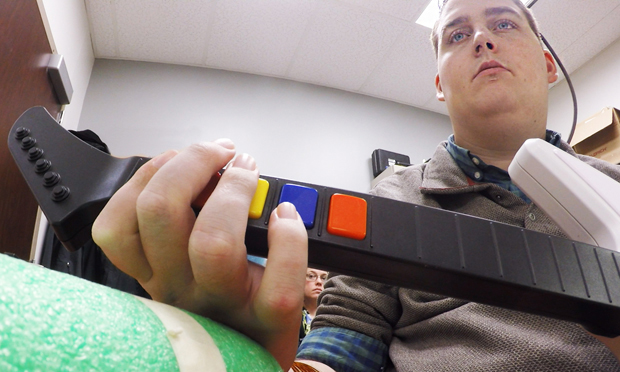Paralyzed man regains hand movement using own brain signals
For the first time, a paralyzed person has been able to perform complex tasks involving hand, wrist, and finger movements using signals recorded from his own brain.
About six years ago, Ian Burkhart became a quadriplegic, losing all function in his arms and legs in a diving accident, just after completing his freshman year of college. He made headlines in 2014 when he became the first paralyzed person to use neural bypass technology called NeuroLife to pick up and hold a spoon using his own brainpower.
Today, with the help of a team of surgeons, engineers, and occupational therapists, the 24-year-old can control his hand and finger movements well enough to grasp and swipe a credit card, pick up a bottle and pour out its contents, and even play a guitar video game.
Researchers say the technology used to help Burkhart could one day assist others living with paralysis. Their findings are published in the journal Nature.
"This study marks the first time that a person living with paralysis has regained movement by using signals recorded from within the brain," study author Chad Bouton of the Feinstein Institute for Medical Research in Manhasset, New York, said in a press briefing. "This of course is an important result and finding as we try to pave the pathway for helping other patients in the future... with spinal cord injury."
Patients who have suffered from stroke and even traumatic brain injury may one day benefit from the treatment, as well, he said.
How it works
The researchers implanted a microelectrode chip in Burkhart's brain, which interprets his thoughts and brain signals using machine-learning algorithms. The signals then bypass the injured spinal cord and connect directly to a sleeve worn on his forearm that stimulates the muscles that control movement in the arm, hand, and fingers.
"Not only are we recording signals from within the brain and not only are we deciphering those signals and telling the difference between when Ian thinks about moving his thumb versus flexing his wrist or moving his index finger, we can actually take those signals and translate them into a language that the muscles can understand," Bouton said. "And we're linking those signals to muscle activation."
Burkhart is the first person to use this technology, which was invented by Battelle.
"The first time when I was able to open and close my hand, it really gave me a sense of hope for my future," he said.
Though being confined to a wheelchair is extremely limiting, Burkhart said not having use of his arms and hands is what really takes away his independence. "I have to rely on so many people for things," he said.
So the abilities he has regained so far could make a big difference in terms of how he can function in his day-to-day life.
"The complex task of picking up a bottle, pouring something in, then picking up a stir bar and stirring the contents of that bottle really can translate into a lot of functional daily tasks that I can't do on my own now," Burkhart said. "So that's something that if or when I can use the system outside of the clinical setting, it will really increase my quality of life and independence and decrease the amount of assistance I need from other people."
The ultimate goal, the researchers said, is to develop a less cumbersome, at-home version of the therapy that can be used by a number of patients.
"We're hoping that this technology will evolve into a wireless system connecting brain signals and thoughts to the outside world to improve the function and quality of life for those with disabilities," Dr. Ali Rezai, a co-author of the study and a neurosurgeon at Ohio State's Wexner Medical Center, said in a statement. "One of our major goals is to make this readily available to be used by patients at home."
Though the researchers could not give a specific timeline for when this might occur, they are hopeful that this technology will one day help more people living with paralysis.
"Ten years or so ago were not able to do this," Rezai said. "Just imagine what we will be able to do 10 years from now."


